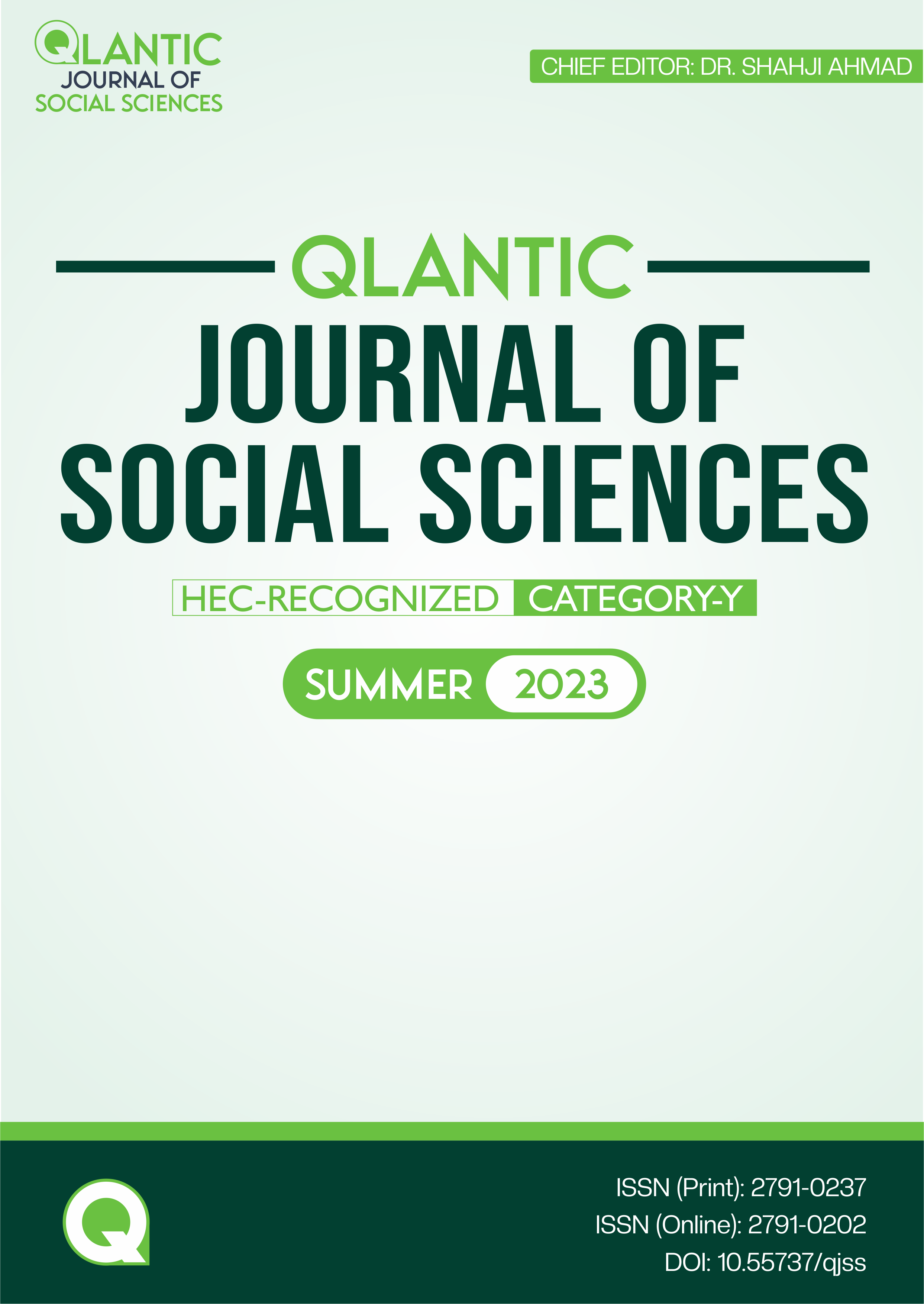A Cultural Transformation: Pakistani Girls Outperforming Boys in Education
DOI:
https://doi.org/10.55737/qjss.355122226Keywords:
Gender, Outperformance, Structure Transformation, Educational Performance, CultureAbstract
In this paper, we highlight and present a nuanced picture of girls’ outperformance and boys’ underperformance in education in the urban centres of Pakistan. This is a very interesting and remarkable gender reverse trend in education performance in the dominated socio-cultural context of Pakistan. The paper takes into account the annual results of two examination boards: a) Board of Intermediate and Secondary Education (BISE) Peshawar and b) Board of Intermediate and Secondary Education (BISE) Faisalabad, Pakistan. Employing content analysis techniques, we have examined young boys’ and girls’ educational performance in secondary school certificate (SSC) and higher secondary schools certificate (HSSC) examinations from 2002 to 2016. The paper takes into account the first three positions as an indicator of outperformance. The paper simply highlights the trend of structure transformation and does not inquire about reasons for boys’ underperformance and girls’ outperformance. The study findings suggest that girls are outperforming boys in the urban centres of Pakistan.
References
Adler, P. A., Kless, S. J., & Adler, P. (1992). Socialization to gender roles: Popularity among elementary school boys and girls. Sociology of Education, 65(3), 169. https://doi.org/10.2307/2112807
Allen, W. (1992). The color of success: African-American college student outcomes at predominantly white and historically Black public colleges and universities. Harvard Educational Review, 62(1), 26-45. https://doi.org/10.17763/haer.62.1.wv5627665007v701
Bauer, K. S. (2000). Promoting gender equity in schools. Contemporary Education, 71(2), 22.
Biddulph, S. (1998). Raising Boys London: Thorsons. In: Harper Collins.
Buchmann, C., & DiPrete, T. A. (2006). The growing female advantage in college completion: The role of family background and academic achievement. American Sociological Review, 71(4), 515-541. https://doi.org/10.1177/000312240607100401
Datta, P. (2014). Self-concept and vision impairment: A review. British Journal of Visual Impairment, 32(3), 200-210. https://doi.org/10.1177/0264619614542661
Dillabough, J.-A. (2006). Gender, Theory and Social Thought: Illuminating Moments and Critical Impasses (1st Ed.). London: SAGE Publications.
Education, F. M. (2018). Pakistan Education Statistics 2016-2017. Islamabad.
Golden, C. G., Bae, Y., Choy, S., Giddes, C., Sable, J., & Snyder, T. (2000). Trends in educational equity of girls and women. The Journal of Negro Education, 69(4), 388. https://doi.org/10.2307/2696256
Good, C., Aronson, J., & Inzlicht, M. (2003). Improving adolescents' standardized test performance: An intervention to reduce the effects of stereotype threat. Journal of Applied Developmental Psychology, 24(6), 645-662. https://doi.org/10.1016/j.appdev.2003.09.002
Gurian, M. (2010). Boys and girls learn differently! A guide for teachers and parents: Revised 10th anniversary edition. John Wiley & Sons.
Hung, A., Yoong, J., & Brown, E. (2012). Empowering women through financial awareness and education. OECD Working Papers on Finance, Insurance and Private Pensions. https://doi.org/10.1787/5k9d5v6kh56g-en
McDowell, L. (2000). Learning to serve? Employment aspirations and attitudes of young working-class men in an era of labour market restructuring. Gender, Place & Culture, 7(4), 389-416. https://doi.org/10.1080/713668883
Mickelson, R. A. (1989). Why does Jane read and write so well? The anomaly of women's achievement. Sociology of Education, 62(1), 47. https://doi.org/10.2307/2112823
Mustafa, G. (2012). Education policy analysis report of Khyber Pakhtunkhwa. Islamabad:
Noureen, G., & Awan, R. -. (2011). Women’s education in Pakistan: Hidden fences on open frontiers. Asian Social Science, 7(2). https://doi.org/10.5539/ass.v7n2p79
Peter, L., & Hull, R. (1969). The peter principle. In: London, England: Souvenir Press.
Rahman, S. (2005). Orientations and motivation in English language learning: A study of Bangladeshi students at undergraduate level. Asian EFL Journal, 7(1), 29-55. https://asian-efl-journal.com/March_05_sr.pdf
Saigol, R. (1997). The gendering of modernity: nineteenth century educational discourse. Engendering the nation-state, 1, 155-186.
Shams, F. (2017). Aid Effectiveness In Education: A Case Study Of Pakistan From 2005-2015. UCL (University College London),
Skelton, C., & education. (2006). Boys and girls in the elementary school: The SAGE handbook of gender.
Statistics, P. E. (2015-16). National Education Management Information System. Islamabad.
Steele, C. M. (1997). A threat in the air: How stereotypes shape intellectual identity and performance. American Psychologist, 52(6), 613-629. https://doi.org/10.1037/0003-066x.52.6.613
Ullah, H. & Khan, N. H. (2014) The Objectification of Women in Television Advertisements in Pakistan, FWU Journal of Social Sciences, 8 (2), 26-35. http://sbbwu.edu.pk/journal/FWUJournal,Winter%202014%20Vol.8,No.2/4.%20The%20Objectification%20of%20Women%20in%20Television.pdf
Ullah, H. (2007). Gender and Curriculum: The Patriarchal Hegemony in Contemporary NWFP. Journal of Gender and Social Issues, 6(2), 12.
Ullah, H. (2013). Reproduction of Class and Gender Hierarchies through Education in Khyber Pakhtunkhwa. Ph. D Thesis-Main Library University of Peshawar, Pakistan.
Ullah, H., & Ali, J. (2012). Male Hegemony through Education: Construction of Gendered Identities. Generos, 1(3), 215–242. https://doi.org/10.4471/generos.2012.11
Ullah, H., & Haque, H. (2016). The Representation of Boys' and Girls' Activities in School Textbooks. Journal of Social Sciences, 10(1), 81-87. http://www.sbbwu.edu.pk/journal/Summmer%202016%20Vol.10.No.1/10%20The%20representation%20of%20byes%20and%20giles%20activities.pdf
Ullah, H., Ali, J., & Ahmad, B. (2018). Doing Gender: Construction of Young Gender Identities in Pakistan. Pakistan Journal of Criminology, 10(1).
Whitney, I., & Smith, P. K. (1993). A survey of the nature and extent of bullying in junior/middle and secondary schools. Educational Research, 35(1), 3-25. https://doi.org/10.1080/0013188930350101




